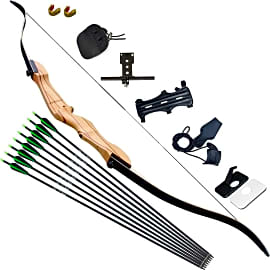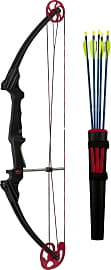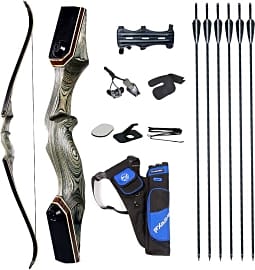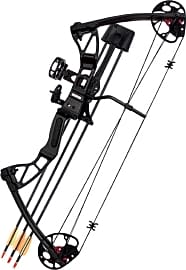The 10 Best Archery Sets

This wiki has been updated 37 times since it was first published in July of 2015. Looking for a new hobby? Satisfy your competitive urge, improve your hand-eye coordination, and strengthen your mental focus with one of the archery sets listed here. We've included models that are ideal for children just beginning the sport as well as options for intermediate archers interested in competitive shooting. Bows are extremely dangerous and should be used with the utmost caution. When users buy our independently chosen editorial recommendations, we may earn commissions to help fund the Wiki.
Editor's Notes
April 02, 2021:
Whenever you or someone around you is practicing archery, caution must be taken and safety procedures should be observed at all times. Adults should always supervise younger generations and encourage responsible shooting. There are a number of sets aimed at youths and these are generally lighter with decreased tension, and rubber-tipped arrows can be purchased for safer use.
When updating our ranking, three sets caught our eye. First is the TopArchery 60-inch, with its excellent craftsmanship that looks like it belongs on a model several times the price. Its sculpted wooden handle is comfortable to grip, and it attaches to two flexible limbs that are made from a composite of fiberglass and bamboo. The set itself comes with a quiver, protective gear, and all the accessories that you need to get started, apart from targets.
Secondly, we included the HYF Takedown Recurve, with its perforated aluminum-magnesium alloy handle which is both light in weight and aesthetically impressive. Again, it comes with a host of accessories, and we approved of the 12 high-quality arrows and bow sight, which greatly improve the user experience. A handy multi-tool is included with the set to ensure that it is always kept in a serviceable condition and it easily collapses for storage.
Finally, we selected the D&Q 68-inch Takedown, as it immediately grabbed our attention with its laminated beech and pear wood riser, which makes it very comfortable to use for long periods while also protecting your bow hand from injury. All of the included accessories are of high quality, especially the eight arrows with fiberglass shafts that will stand up to many repetitive shots, and it is available in draw weights of 20, 30, and 40 pounds.
February 05, 2020:
Removed the Barnett Sportflight because of availability issues. Added the D&Q Survival.
Both the Southwest Archery Samick Sage and the Siege SAS-750 are excellent bows that, while quite accessible to novices, can easily be used to hunt thanks to their draw weights. Choosing between the two will amount to deciding whether you prefer to use a recurve bow (the Sage) or a compound bow (the 750). I tend to favor recurves because they are cheaper for the quality, simpler (and therefore have less parts that can fail), are easier to maintain, and feel more traditional. They are however more difficult to master and greater strength is required to use them than compound bows that produce similar velocities (I use a 55 pound Sage that is nearly impossible to use for most people).
One advantage of compound bows in general is that their draw weights can be adjusted at the cams whereas a non-takedown recurve has only one possible draw weight. This is not a limitation of takedown recurve bows like the Samick Sage whose draw weight can be adjusted by replacing the limbs.
Bows are extremely dangerous and should be used with great caution. Never point a bow at another person and never dry-fire a bow. Check your local regulations for restrictions on bow use and draw-weights.
Special Honors
Custom Made Archery Equipment Listings Choose from a selection of hand-crafted archery equipment and accessories at this artisan-style site. The collection ranges from bowstrings and cables, to leather quivers, traditionally-made arrows, and high-performance bows. While much of it wouldn't look out of place on the set of Game of Thrones, there's no doubting the craftsmanship and effort that goes into each and every piece. custommade.com
A Brief History Of Archery
Historians believe that archery spread to the Americas in roughly 6,000 B.C.E. by way of Alaska.
A bow and arrow is one of the oldest projectile weapons still in use today, though in modern times most civilizations use them for recreation rather than warfare. Throughout history, archery was a vital hunting and military skill required for survival. The weapon plays such a prominent role in human history that it found its way into the mythologies of many cultures. For example, Arash, a legendary archer in Iranian lore, shot an arrow that traveled for three days before landing and determining the border between Persia and Tooran.
It is unknown exactly when humans first started using the bow and arrow. There is direct evidence showing mankind using the bow and arrow at least 8,000 years ago, but indirect evidence points to their use some 10,000 years ago or more. Many academics believe that humans made use of the bow and arrow as much as 40,000 or 50,000 years ago. In fact, recent discoveries in the Sibuda Cave in South Africa point to evidence of the bow and arrow existing 64,000 years ago. It is interesting to note that pre-civilized people on nearly every continent developed a similar form of bow and arrow.
Archeologists found the oldest definitive bows in Holmegård swamp in Denmark. They are made of elm wood and date back to roughly 6,000 B.C.E. Archeologists also found what they believe to be arrows dating back to sometime between 9,000 and 7,000 B.C.E. near Hamburg, Germany. These primitive arrows had a pine shaft and flint points. Shallow grooves near the base indicate they were shot from a bow, but the evidence is not conclusive.
Historians believe that archery spread to the Americas in roughly 6,000 B.C.E. by way of Alaska. It most likely didn't arrive in temperate zones until some 4,000 years later. It wasn't until the advent of the firearm in the 12th or 13th century that the bow and arrow began to wane as the prominent projectile weapon for military use. By the 1500s, most European armies had begun to replace archers with firearm divisions. Armies in China, however, continued to use bows and arrows alongside firearms until as recently as the 1800s.
Understanding The Different Types Of Bows
While there have been different types of bows throughout the years, modern bows generally come in three distinct styles: longbows, recurve bows, and compound bows.
Longbows are the most traditional form still commonly used today. Soldiers used them in battle from the 13th to 16th centuries C.E. Longbows are so named because of their size, which is often roughly equal to the height of the user. As you might imagine, this makes them somewhat unwieldy and difficult for beginners to use. Their long size also means they have a fairly long draw that requires a good deal of strength.
These only have bow limbs, a string, an arrow rest, and a riser.
Recurve bows address some of the shortcomings of the traditional longbow, mainly the size to power ratio. Because of the unique design of recurve bows, in which the tips of the limbs curve away from the archer rather than towards them, they are able to store and produce a greater amount of energy in a smaller form. This made them ideal for use in pursuits where a longbow was problematic, such as on horseback or in dense brush. It also makes them a good choice for beginners, as they don't require nearly as much energy to produce high-velocity shots. Most beginners learn on barebow recurves. These only have bow limbs, a string, an arrow rest, and a riser. As a student's skill increases, they may begin to use recurve bows with more accessories, such as stabilizers, pressure buttons, and sights.
Compound bows make use of a complex system of pulleys and eccentric cams that make it easier to hold the bow at full draw. The limbs of compound bows are more rigid than those of longbows or recurve bows, which means they require more strength to initially draw the bow. The high rigidity makes them more energy-efficient and capable of extremely powerful shots. The idea behind the compound bow is to give the archer more time to aim their shot, without causing excessive fatigue. Compound bows may have a recurve or traditional longbow shape. Due to the complex design, compound bows are not recommended for beginners.
Common Methods To Practice Archery
Most modern bow and arrow enthusiasts participate in one of four types of archery pursuits: target, field, 3D, or bowhunting. Each form requires different skills, and the type you plan on participating in will have some impact on which type of bow you should purchase.
In 3D archery, archers shoot at life-sized, three-dimensional targets in the shape of a variety of different animals.
In target archery, archers stand with their feet level with a stationary shooting line and shoot at distance-denoted, fixed-position targets. Archers can use any type of bow in target archery. Those who find the concept of standing in a single position and repeatedly shooting at a target boring, may be more interested in field archery. In field archery individuals or teams work their way through a course, often set over rough terrain, shooting at targets from pre-set colored pegs in the ground. Each set of pegs is placed at a specific distance from the target depending on the skill division. Most archers in field archery use compound or recurve bows.
In 3D archery, archers shoot at life-sized, three-dimensional targets in the shape of a variety of different animals. The targets are most often made from foam. Traditionally, most archers participated in 3D archery as a way to hone their skills for bowhunting, but it is gaining in popularity as a purely recreational sport. Unlike with field or target archery, there are no shot distance markings in 3D archery, which means the archer must know how to properly estimate distance. Bowhunting is exactly what it sounds like: the practice of hunting game using a bow and arrow. The majority of 3D archers and bowhunters use compound bows.















